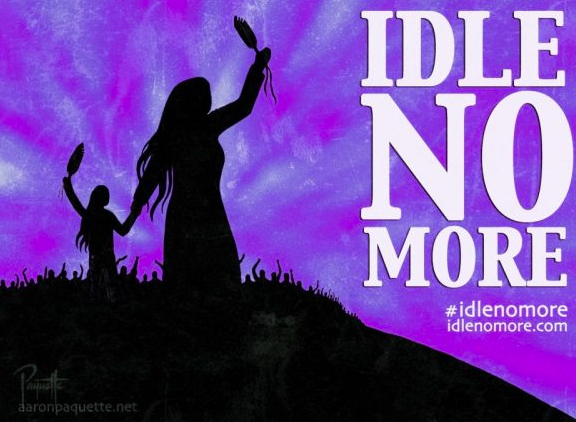Change the conversation, support rabble.ca today.
Nearly a month has passed since several Chiefs were physically denied access to the House of Commons to voice their concerns about changes that were about to be forced upon First Nations communities in the federal budget bill.
This, combined with the work done through teach-ins in cities in Saskatchewan throughout the Fall culminated in the first day of action called for Dec. 10 in the name of Idle No More.
With journalists slow on covering the Idle No More movement, the privacy offered by this group (sometimes mistaken for vultures) helped ensure that the grassroots could quietly develop the confidence needed to organize creative actions. No questions about leaders. No divisions magnified. No media tricks.
Amid stories about shopping and Christmas, the mainstream press awoke to find a groundswell of support and action in communities across Canada. It was national. It was leaderless. It was grassroots. It was everything that the mainstream media is not equipped to write about.
Then it started: The errors. The questions about leaders, chiefs and the cracks in the movement. The racist comments.
The current state of shorthand journalism dictates that every story should have two sides: one side is the little guy and the other is the powerful guy, as if the biblical tale of David and Goliath is an allegory for every single political conflict that may arise.
While there are parallels between this narrative and Indigenous struggle against colonialism, it isn’t the story of two people. It’s the story of hundreds of nations, millions of people dead, millions of survivors, hundreds of languages, one Crown with hundreds of agents, thirteen provinces and infinite excuses. This is too complex for a soundbite. This is too complex for a 30-second TV spot.
It is under these conditions that divisions start to surface, exploited both by accident by these constraints and on purpose by columnists who intend to dismiss or dehumanize Indigenous people and their movements.
On one hand, this story of genocide, colonization and neo-colonization is simple: settlers were brought by colonizing empires to settle “Canada” and push away the Indigenous populations. The result was centuries of government-sponsored murder or forced assimilation. As communities evolved to better resist this legacy, the Federal government looked at ways to take even more of their lands because of the mining, oil, gas or forestry opportunities that exist above or below. The result is a lopsided arrangement where few benefit and many suffer.
But this story is laden with complexities: complex identities and players, roles, legal statuses, histories, denial, exploitation, exploited divisions, bribery, theft, bureaucracy, legislated identities, apartheid.
Idle No More is compelling partly because it is so complex. It implicates everyone living in Canada. If we have ancestors who lived here, it implicates them too.
Idle No More risks being written off by the mainstream press much in the way that Occupy Wall Street was; sure, the campaign has noble goals but its leaderless, multi-issue approach will ensure that it fizzles out.
Activists need to learn from the strengths and weaknesses of other social movements and, already, it’s clear that mistakes made by Occupy are not being reproduced. Spokespeople have emerged who are talented speakers and who are generous enough with their time to do the all-consuming TV circuit. Like during the Québec student strike, events are springing up across Canada daily, keeping the momentum of the movement alive.
Idle No More is strong because it is a grassroots movement. As long as people continue to demonstrate it will remain a grassroots movement. And, the longer these events go on, the more vicious the attacks against Indigenous people and the movement will become.
Unfortunately, federal politicians know this terrain; they have had centuries of learning how to most effectively divide Indigenous communities and people and foster in-fighting. Just look at Jason Kenney’s Twitter feed to see how this plays out. And when the mainstream press views the roles of chiefs as being to control their people, as stated in a Globe and Mail headline, the analysis of the complex issues is nearly always to be just as offensive and fall just as flat. Both forces will be working in different ways to ensure Idle No More goes away.
The resilience of the movement will lie in the resilience of people to continue to rally, to flashmob, to write letters, to interrupt economic activity and to ensure that “life as usual” ceases to exist for the folks in Ottawa. We need to expose attempts to divide or co-opt the movement in a way that is accessible and easy for people to understand.
Through our collective creativity, our thirst for justice and our desire to fight the powers who are imposing their agendas on us all, the attempts to break Idle No More that will inevitably come cannot be successful.




